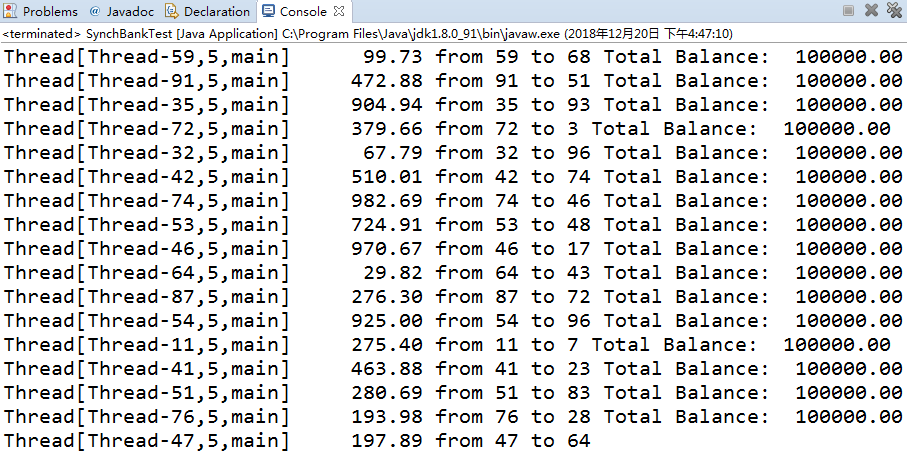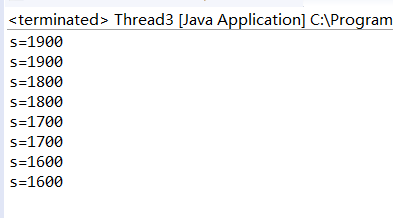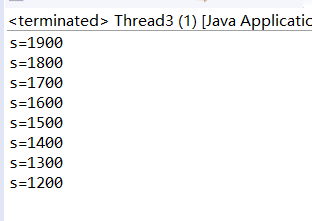劉志梅201771010115.《面向物件程式設計(java)》第十七週學習總結
實驗十七 執行緒同步控制
實驗時間 2018-12-10
1、實驗理論知識
多執行緒
多執行緒是程序執行過程中產生的多條執行線索。
程序
執行緒是比程序執行更小的單位。執行緒不能獨立存在,必須存在於程序中,同一程序的各執行緒間共享程序空間的資料。每個執行緒有它自身的產生、存在和消亡的過程, 是一個動態的概念。執行緒建立、銷燬和切換的負荷遠小於程序,又稱 為輕量級程序(lightweight process)。
Java實現多執行緒
-建立Thread類的子類
-在程式中定義實現Runnable介面的類
用Thread類的子類建立執行緒
首先需從Thread類派生出一個子類,在該子類中 重寫run()方法。
class hand extends Thread { public void run() {……} }
然後用建立該子類的物件
Lefthand left=new Lefthand();
Righthand right=new Righthand();
最後用start()方法啟動執行緒
left.start();
right.start();
用Runnable()介面實現執行緒
首先設計一個實現Runnable介面的類;
然後在類中根據需要重寫run方法;
再建立該類物件,以此物件為引數建立Thread 類的物件;
呼叫Thread類物件的start方法啟動執行緒,將 CPU執行權轉交到run方法。
執行緒的終止:呼叫interrupt()方法。
多執行緒併發執行不確定性問題解決方案:引入線 程同步機制,使得另一執行緒要使用該方法,就只 能等待。
在Java中解決多執行緒同步問題的方法有兩種: - Java SE 5.0中引入ReentrantLock類。 - 在共享記憶體的類方法前加synchronized修飾符。
2、實驗內容和步驟
實驗1:測試程式並進行程式碼註釋。
測試程式1:
l 在Elipse環境下除錯教材651頁程式14-7,結合程式執行結果理解程式;
l 掌握利用鎖物件和條件物件實現的多執行緒同步技術。
import java.util.*; import java.util.concurrent.locks.*; /** * A bank with a number of bank accounts that uses locks for serializing access. * @version 1.30 2004-08-01 * @author Cay Horstmann*/ public class Bank//Bank類 { private final double[] accounts;//銀行運轉的基礎資料 private Lock bankLock; private Condition sufficientFunds; /** * Constructs the bank. * @param n the number of accounts * @param initialBalance the initial balance for each account */ public Bank(int n, doubleinitialBalance) { accounts = new double[n]; Arrays.fill(accounts, initialBalance);//呼叫initialBalance生成鎖物件屬性 bankLock = new ReentrantLock(); sufficientFunds = bankLock.newCondition(); } /** * Transfers money from one account to another. * @param from the account to transfer from * @param to the account to transfer to * @param amount the amount to transfer */ public void transfer(int from, int to, double amount) throws InterruptedException { bankLock.lock(); //臨界區加鎖 try { while (accounts[from] < amount) sufficientFunds.await();//用鎖物件生成條件物件sufficientFunds System.out.print(Thread.currentThread()); accounts[from] -= amount; System.out.printf(" %10.2f from %d to %d", amount, from, to); accounts[to] += amount; System.out.printf(" Total Balance: %10.2f%n", getTotalBalance()); sufficientFunds.signalAll(); } finally { bankLock.unlock(); } } /** * Gets the sum of all account balances. * @return the total balance */ public double getTotalBalance() { bankLock.lock(); try { double sum = 0; for (double a : accounts) sum += a; return sum; } finally { bankLock.unlock(); } } /** * Gets the number of accounts in the bank. * @return the number of accounts */ public int size() { return accounts.length; } }
/** * This program shows how multiple threads can safely access a data structure. * @version 1.31 2015-06-21 * @author Cay Horstmann */ public class SynchBankTest { public static final int NACCOUNTS = 100; public static final double INITIAL_BALANCE = 1000; public static final double MAX_AMOUNT = 1000; public static final int DELAY = 10; public static void main(String[] args) { Bank bank = new Bank(NACCOUNTS, INITIAL_BALANCE); for (int i = 0; i < NACCOUNTS; i++) { int fromAccount = i; Runnable r = () -> { try { while (true) { int toAccount = (int) (bank.size() * Math.random()); double amount = MAX_AMOUNT * Math.random(); bank.transfer(fromAccount, toAccount, amount); Thread.sleep((int) (DELAY * Math.random())); } } catch (InterruptedException e) { } }; Thread t = new Thread(r); t.start(); } } }

測試程式2:
l 在Elipse環境下除錯教材655頁程式14-8,結合程式執行結果理解程式;
l 掌握synchronized在多執行緒同步中的應用。
/** * This program shows how multiple threads can safely access a data structure, * using synchronized methods. * @version 1.31 2015-06-21 * @author Cay Horstmann */ public class SynchBankTest2 { public static final int NACCOUNTS = 100; public static final double INITIAL_BALANCE = 1000; public static final double MAX_AMOUNT = 1000; public static final int DELAY = 10; public static void main(String[] args) { Bank bank = new Bank(NACCOUNTS, INITIAL_BALANCE);//建立一個銀行物件 for (int i = 0; i < NACCOUNTS; i++) { int fromAccount = i; Runnable r = () -> { try { while (true) { int toAccount = (int) (bank.size() * Math.random());//拿出一個隨機賬戶 double amount = MAX_AMOUNT * Math.random();//設定隨機一筆錢 bank.transfer(fromAccount, toAccount, amount);//轉賬操作 Thread.sleep((int) (DELAY * Math.random()));//隨機休眠時間 } } catch (InterruptedException e) { } }; Thread t = new Thread(r);//建立一個執行緒 t.start();//執行緒處於可執行狀態 } } }
import java.util.*; /** * A bank with a number of bank accounts that uses synchronization primitives. * @version 1.30 2004-08-01 * @author Cay Horstmann */ public class Bank { private final double[] accounts; /** * Constructs the bank. * @param n the number of accounts * @param initialBalance the initial balance for each account */ public Bank(int n, double initialBalance) { accounts = new double[n]; Arrays.fill(accounts, initialBalance); } /** * Transfers money from one account to another. * @param from the account to transfer from * @param to the account to transfer to * @param amount the amount to transfer */ public synchronized void transfer(int from, int to, double amount) throws InterruptedException { while (accounts[from] < amount) wait();//使執行緒處於等待集中 System.out.print(Thread.currentThread()); accounts[from] -= amount; System.out.printf(" %10.2f from %d to %d", amount, from, to); accounts[to] += amount; System.out.printf(" Total Balance: %10.2f%n", getTotalBalance()); notifyAll();//喚醒所有等待的執行緒 } /** * Gets the sum of all account balances. * @return the total balance */ public synchronized double getTotalBalance() { double sum = 0; for (double a : accounts) sum += a; return sum; } /** * Gets the number of accounts in the bank. * @return the number of accounts */ public int size() { return accounts.length; } }

測試程式3:
l 在Elipse環境下執行以下程式,結合程式執行結果分析程式存在問題;
l 嘗試解決程式中存在問題。
| class Cbank { private static int s=2000; public static void sub(int m) { int temp=s; temp=temp-m; try { Thread.sleep((int)(1000*Math.random())); } catch (InterruptedException e) { } s=temp; System.out.println("s="+s); } }
class Customer extends Thread { public void run() { for( int i=1; i<=4; i++) Cbank.sub(100); } } public class Thread3 { public static void main(String args[]) { Customer customer1 = new Customer(); Customer customer2 = new Customer(); customer1.start(); customer2.start(); } } |
class Cbank { private static int s=2000;//當類載入時s賦值為2000 public static void sub(int m) { int temp=s; temp=temp-m; try { Thread.sleep((int)(1000*Math.random())); } catch (InterruptedException e) { }//捕獲中斷異常 s=temp; System.out.println("s="+s); } } class Customer extends Thread//繼承 { public void run()//中值返回 { for( int i=1; i<=4; i++) Cbank.sub(100); } }
public class Thread3 { public static void main(String args[]) { Customer customer1 = new Customer();//把變數customer1的值設定為分配給新的Customer物件的內部地址 Customer customer2 = new Customer(); customer1.start(); customer2.start(); } }

修改後的程式碼:
class Cbank { private static int s=2000; public synchronized static void sub(int m) { int temp=s; temp=temp-m; try { Thread.sleep((int)(1000*Math.random())); } catch (InterruptedException e) { } s=temp; System.out.println("s="+s); } } class Customer extends Thread { public void run() { for( int i=1; i<=4; i++) Cbank.sub(100); } } public class Thread3 { public static void main(String args[]) { Customer customer1 = new Customer(); Customer customer2 = new Customer(); customer1.start(); customer2.start(); } }

實驗2 程式設計練習
利用多執行緒及同步方法,編寫一個程式模擬火車票售票系統,共3個視窗,賣10張票,程式輸出結果類似(程式輸出不唯一,可以是其他類似結果)。
Thread-0視窗售:第1張票
Thread-0視窗售:第2張票
Thread-1視窗售:第3張票
Thread-2視窗售:第4張票
Thread-2視窗售:第5張票
Thread-1視窗售:第6張票
Thread-0視窗售:第7張票
Thread-2視窗售:第8張票
Thread-1視窗售:第9張票
Thread-0視窗售:第10張票
package tracket; public class tracket { public static void main(String[] args) { Mythread mythread = new Mythread(); Thread t1 = new Thread(mythread);//例項化了一個Thread物件thread1 Thread t2 = new Thread(mythread); Thread t3 = new Thread(mythread); t1.start();//執行緒啟動 t2.start(); t3.start(); } } class Mythread implements Runnable { int t = 1; boolean flag = true; @Override public void run() { // TODO Auto-generated method stub while (flag) { try { Thread.sleep(500);//休眠時間500毫秒 } catch (Exception e) { // TODO: handle exception e.printStackTrace(); } synchronized (this) { if (t <= 10) { System.out.println(Thread.currentThread().getName() + "視窗售:第" + t + "張票"); t++; } if (t > 10) { flag = false; } } } } }

實驗總結:本週實驗學習了執行緒的同步,對執行緒有了更能進一步的學習,最後的程式設計的練習題通過學長的講解以及演示,程式碼語句的解釋,深入瞭解執行緒同步問題;本週也是最後一週的實驗,這學期通過老師和學長的教學學習到了不少java的知識,非常感謝。
